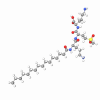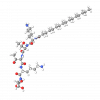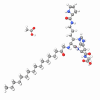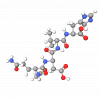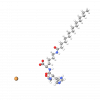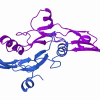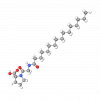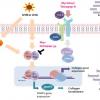sh-Polypeptide-50 is a single-chain synthetic recombinant peptide that repeats a part of the amino acid sequence of Tropoelastin, a protein produced inside fibroblasts. After transfer into the extracellular space (out of the fibroblast), water-soluble Tropoelastin converts into water-insoluble Elastin.
Multiple studies have shown that elastin hydrolyzates and elastin-derived peptides accelerate wound healing and skin regeneration. They improve fibroblast proliferation, enhance production of Type I Collagen, and increase Tropoelastin.
sh-Polypeptide-50 is the active ingredient that improves dermal resilience, known under the trade names Prolastil E-50 and Elastapure. According to manufacturers' claims, it restores skin elasticity and reduces visible signs of aging. The peptide is claimed to be able to penetrate the epidermis and stimulate fibroblasts, thereby boosting the production of collagen and other extracellular matrix proteins by mimicking the behavior of native elastin fragments.
According to manufacturer-released data:- A clinical study conducted by researchers at Thomas Jefferson University Medical School evaluated the effects of Prolastil E-50 on aging skin using a face cream and an eye serum.
- In a 56-day split-face study (n = 46), participants applied Prolastil E-50 to one half of their face and a placebo to the other.
- Profilometry and photography demonstrated a reduction of up to 45% in wrinkle depth, volume, and surface area.
- A separate 42-day tolerance study (n = 28) reported high compatibility, with most participants noting improvements in texture, hydration, and elasticity.
F.A.Q.
Does sh-Polypeptide-50 penetrate the skin?
Yes, according to in vivo and in vitro studies by the manufacturer.
- Tropoelastin, the proprietary elastin analog in sh-Polypeptide-50, was shown to penetrate the stratum corneum and reach layers 6–14 within 1 hour of application (Usher, T.C., US Patent #4,659,740).
- Microscopy confirmed epidermal absorption within 24 hours.
- In cultured cells, up to 4.6 µg of tropoelastin was incorporated into a 400 cm² layer—equivalent to the surface area of an average face (Stone et al., 2001).
Is sh-Polypeptide-50 effective for reducing wrinkles and improving skin elasticity?
Yes, according to manufacturer-released clinical data.
In a 56-day split-face study involving 46 volunteers aged 39–74, a cream containing sh-Polypeptide-50 (as part of the Prolastil E-50 formulation) was applied to one half of the face, while a placebo was used on the other.
Results:
- Up to 45% reduction in the depth, volume, and surface area of deep wrinkles
- Improvements were assessed using profilometry and photography
